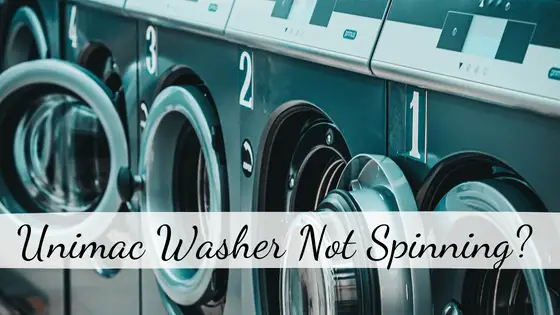Is your Unimac washer not spinning? What could be the cause?
The short answer is that there could be a few different causes, such as an obstructed pump, a broken belt, a faulty lid switch, an overloaded washer, or a faulty motor.
Frustrating, isn’t it?
Don’t worry; you’re not alone.
Many people have experienced the frustration of a washer that won’t spin.
But before you panic and call a repair technician, there are a few things you can try yourself to fix the problem.
In this article, we’ll go over five common causes of a Unimac washer not spinning and the steps you can take to fix them.
So, if your Unimac washer isn’t spinning as it should, keep reading for potential solutions.
Common Causes of a Unimac Washer Not Spinning
Obstructed Pump
Obstructed Pump One of the most common causes of a Unimac washer not spinning.
The pump is responsible for draining the water from the tub and if it’s obstructed, the washer won’t be able to spin.
To check for an obstructed pump, start by unplugging the washer and removing the access panel.
Look for any debris, such as coins or lint, that may be blocking the pump.
If you find any, remove it carefully and try running the spin cycle again.
Broken Belt
Broken Belt is another common cause of a Unimac washer not spinning.
The belt connects the motor to the tub and if it’s broken, the washer won’t be able to spin.
To check for a broken belt, unplug the washer and remove the access panel.
Look for any visible signs of wear or damage on the belt.
If the belt is broken, you’ll need to replace it.
Faulty Lid Switch
The lid switch is responsible for detecting when the lid is closed and it’s a common cause of a washer not spinning.
If the switch is faulty, the washer won’t be able to spin.
To check the lid switch, unplug the washer and locate the switch.
Test the switch by pressing it down with a small tool, such as a screwdriver.
If the switch is faulty, you’ll need to replace it.
Overloaded Washer
An overloaded washer is a common cause of a washer not spinning.
When a washer is overloaded, it can become unbalanced and the spin cycle may not work properly.
This can be caused by trying to wash too many items at once or by not evenly distributing the load
Faulty Motor
If none of the above causes are the problem, the issue may be with the motor.
The motor is a crucial component of your washer and it’s responsible for turning the tub.
If the motor is faulty, the washer won’t be able to spin.
A faulty motor can be caused by a variety of issues, such as a damaged wire, a faulty capacitor, or a worn-out motor.
If you suspect the motor is the problem, it’s important to diagnose and address the issue as soon as possible to avoid further damage to your washer.
Here’s What to Do When Your Unimac Washer Not Spinning- Solutions
Clean the Pump
If you’ve determined that an obstructed pump is the cause of your washer not spinning, the first fix you can try is cleaning the pump.
Start by unplugging the washer and removing the access panel.
Look for any debris, such as coins or lint, that may be blocking the pump.
Carefully remove any debris you find and try running the spin cycle again.
If the problem persists, you may need to clean the pump more thoroughly.
To do this, you’ll need to remove the pump and clean it with a soft brush or cloth.
Make sure to reassemble the pump correctly and try the spin cycle again.
Replace the Belt
If you’ve determined that a broken belt is the cause of your washer not spinning, you’ll need to replace it.
A broken belt is a common cause of a washer not spinning and it’s usually an easy fix.
To replace the belt, start by unplugging the washer and removing the access panel.
Locate the belt and remove it by loosening the tension pulley or slipping it off the motor and tub pulleys.
Next, purchase a replacement belt from an appliance parts store or online.
Follow the instructions included with the new belt to install it correctly.
Make sure the belt is properly tensioned and try the spin cycle again.
Replace the Lid Switch
If the lid switch is faulty, you’ll need to replace it.
The lid switch is responsible for detecting when the lid is closed and it’s a common cause of a washer not spinning.
To replace the lid switch, start by unplugging the washer and locating the switch.
Follow the instructions included with the new switch to install it correctly.
Make sure to properly connect the wires and test the switch by pressing it down with a small tool, such as a screwdriver.
If the switch is working properly, try the spin cycle again.
Reduce the Load Size
If you’ve determined that an overloaded washer is the cause of your washer not spinning, the fix is simple – reduce the load size.
Overloading the washer can cause it to become unbalanced, which can prevent the spin cycle from working properly.
To fix this problem, remove some of the items from the washer and try running the spin cycle again. Make sure to evenly distribute the load and avoid overloading the washer in the future.
Call a Repair Technician to fix the motor
If you’ve determined that the motor is the cause of your washer not spinning, you’ll need to call a repair technician to diagnose and fix the issue.
A faulty motor is a more serious problem that requires professional attention to fix the motor.
A technician will be able to determine the exact cause of the problem and provide a solution.
Make sure to describe the issue accurately and provide the model and serial number of your washer to the technician to help with the diagnosis.
Summing Up
If none of the above fixes seem to be working, there may be another issue with your washer.
In this case, it’s best to call a repair technician to diagnose the problem and provide a solution.
Repair technicians are trained to identify and fix issues with appliances, so they are equipped to handle more complex problems that you may not be able to fix on your own.
Before calling a technician, make sure to gather all relevant information about the issue, including the model and serial number of your washer and any error codes that may be displayed.
This will help the technician diagnose the problem more quickly and provide a more accurate solution.
Sources:
https://unimac.com/wp-content/uploads/2019/09/8-805002en.pdf
Related Articles:


